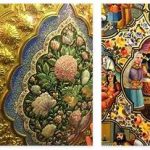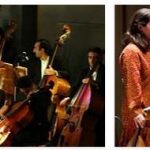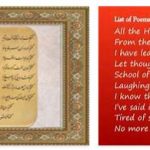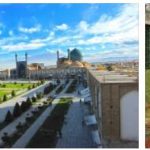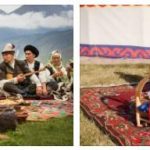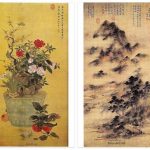The development of Iranian education has been analogous to that of the Arab nations. The Constitution of 1906 established the principle of compulsory schooling but only in 1942 was a law enacted in this regard which was applied after the Second World War. Officially, education is compulsory for all children aged 6 to 11, but in rural areas this requirement is largely disregarded. The school system provides a primary school, free, which begins at 5 years and lasts for five years. Secondary education, which ranges from 11 to 18 years, is divided into two cycles, one of three and the other of four years. In the country there are about twenty universities (one of which in Tehran), which underwent a period of forced closure between 1980 and 1983. After the Khomeinist revolution, mixed schools were also abolished and artistic institutes were reduced. The percentage of illiterates present in the country was 17.7% in 2006. Although the difference between male and female literacy is particularly high, there has been a significant alignment, to the point that there are more women in higher education than men.
CULTURE: ART
The first Iranian artistic manifestations took place in the fifth and fourth millennium BC. C. with the cultures known as “painted ceramics” and are made up of clay vases decorated with lively paintings, first with geometric motifs and then with animal figures – the predominant motif of all Iranian art – or even human ones. Central Iranian painted pottery is documented above all in Tepe Siyalk near Kāshān (from the Siyalk I period it is also the oldest sculpture, a sickle bone handle with a human figure), but in the period of its greatest flowering, i.e. in the second half of the IV millennium (Siyalk III), it also extended in northeastern Iran (lower strata of Tepe Hiran). Perhaps contemporary was the beginning of the art of Lorestān (excavations by Tepe Giyan near Nihawend). In Khuzistān and Fārs painted pottery reached its greatest development in the fourth millennium (Susa I). In this area, with the appearance of monumental architecture and the formation of the first city-states, the Elamite civilization developed from the third millennium, more or less influenced, in different periods, by the Mesopotamian one and which reached its greatest splendor in the sec.
XIII and XII a. C. with large monumental constructions (Dur Untash) and bronze sculptures. In the other regions of Iran, artistic manifestations were influenced, in the third and second millennium, by Elamite and Mesopotamian art. In western Iran, a country located in Middle East according to topmbadirectory, the culture of Tepe Giyan perhaps belongs to the Lullubites; in Sar-i Pul are some of the oldest rock reliefs. In north-eastern Iran the Gorgān culture (excavations of Tepe Hissar and Turang-Tepe) developed in the third millennium with the formation of proto-urban centers, which were superimposed on the new Aryan settlements from the second millennium onwards. The development of metallurgy is noteworthy and partly original (figured golden vases and other objects from the Asterabad treasury). Even richer was the production of Lorestān bronzes decorated with animals and fantastic beings. The Sakkez treasure, in Kurdistān, including Assyrian, Scythian and local Mannean art objects, clearly documents the evolution of the art of the region up to the century.
VII-VI a. C. From the century VI to IV a. C. developed in Iran, the center of the great Persian empire, the splendid Achaemenid art, which was formed above all under Ciro (Pasargadae) and reached its greatest splendor under Darius and Xerxes. Characterized by the monumental architecture of the imperial cities of Persepolis and Susa, seat of the “king of kings”, by the grandiose rock reliefs and the royal tombs (rock tombs of Darius I, Xerxes I, Artaxerxes I, Darius II in Naqsh-i Rustam), also reached high levels in the refined production of pottery, jewels, gold objects and other precious materials. After the conquest of Alexander the Great and the period of the Seleucids, Iran became part of the great Parthian dominion, whose art is however better known from the findings of Mesopotamia; some rock reliefs are important in Iran, including those of Behistūn and Tang-i Sarvak and the bronze sculptures of Malamir (Shami). A new exceptional artistic flourishing occurred with the Sassanid dynasty (224-650 ca.). The aristocratic Sassanid art, aimed entirely at the glorification of the sovereign (grandiose reliefs on rock in honor of Ardashīr, Šāpūr I, Bahram III, Šāpūr II in Naqsh-i Rustam) and of the great feudal lords, while referring back to Achaemenid art, of which it was considered a renaissance, continued the Parthian tradition, especially in architecture (vault, īvān), with an always greater preponderance of oriental motifs compared to Hellenistic ones; the goldsmith’s art was highly developed, often brightly polychrome. Important Sassanid monumental remains are found in Ardashīr-Hurra (today’s Firūzābād, Giund-i Šāpūr at today’s Dezfūl, Bishapur, Sarvistān in the Fārs.

